AI Journey
Every great transformation begins with momentum. And every transformation needs the right AI adoption starting point. And in AI, momentum is everything.
Selecting the right AI adoption starting point for your business-specific AI initiative isn’t just a technical decision—it’s a strategic one. Choose well, and you accelerate adoption, inspire confidence, and pull ahead of your competition. Choose poorly, and your project stalls before it ever gets off the ground.
That’s why this question—“Where should we start?”—is one of the most critical in AI strategy. It determines not only your early ROI but your organization’s ability to sustain innovation over time.
So let’s talk about how to build that momentum.
Why the Right Starting Point Matters
Across industries, roughly 88% of companies are adopting AI, yet only about 44% of those projects succeed. That’s essentially a coin flip—and for any executive, those odds are unacceptable.
The difference between success and failure often comes down to sequencing: where you begin, how you prioritize, and how quickly you convert early results into lasting capability.
When you select a high-payoff, AI adoption starting point—one that’s both feasible and strategically meaningful—you create what I call compounding leverage. You see early wins, which energize your teams, secure executive buy-in, and free up resources for broader rollout.
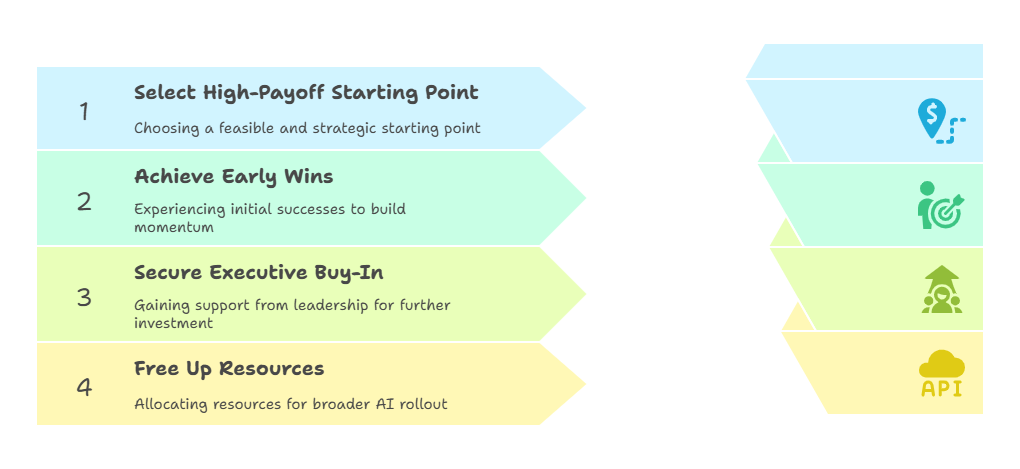
If you like leverage, stay with me. Because the following three pillars of AI sequencing will show you how to achieve the highest ROI and build results you can point to.
Pillar 1: Focus on Augmentation, Not Replacement
At its core, AI is an advanced form of pattern recognition—software that reasons and interacts more naturally with us. But it’s still software.
The businesses that win with AI understand this fundamental truth: AI’s greatest value lies in augmentation, not automation.
Start where your people spend too much time on repetitive, manual work. That might be:
-
Searching through scattered data across systems
-
Manually pulling performance metrics from multiple sources
-
Triaging common customer or internal support requests
In each of these cases, AI can make data accessible, actionable, and secure—empowering the right people to make better decisions faster.
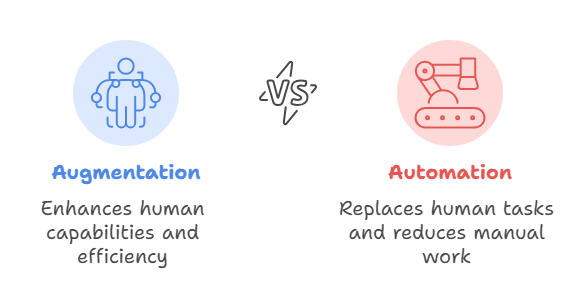
For example, one organization we worked with built an internal knowledge lookup tool that replicated the expertise of their top subject matter experts. This gave teams instant access to high-value insights that were previously trapped in people’s heads or buried in documentation.
The result? Faster onboarding, quicker decision-making, and a workforce that feels instantly more capable.
Remember, momentum builds when AI removes friction—not when it threatens to replace people.
Pillar 2: Feed AI High-Quality, Business-Specific Data
The second pillar of success is data quality. AI doesn’t perform magic—it synthesizes what you feed it. If your data is incomplete, unstructured, or inconsistent, your AI outcomes will reflect that.
So before you even think about model selection and your AI adoption starting point, ask yourself:
-
Where is my richest, most credible data today?
-
Which teams are already capturing conversations, recordings, or workflows?
-
What processes generate repeatable, structured information that AI can learn from?
You might be surprised by what you already have. Training sessions, sales calls, support recordings, and operational logs are all goldmines for building your internal knowledge foundation.
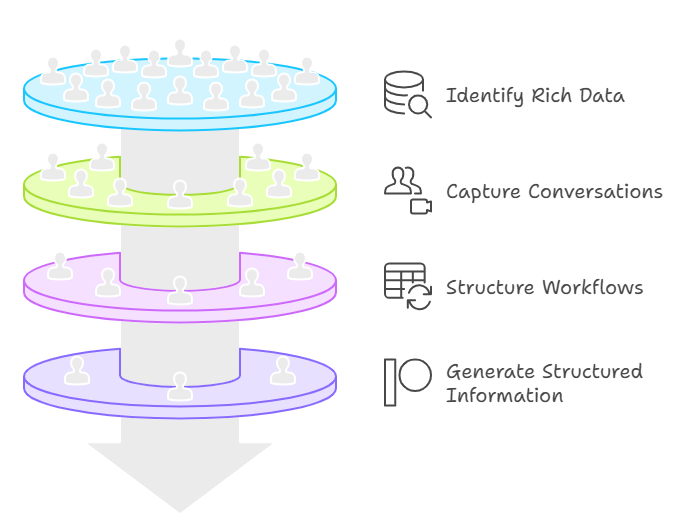
Encourage your teams to document, record, and share insights—every touchpoint adds to your organization’s collective intelligence. Incentivize this behavior if you can; data is your new competitive currency.
If you’re unsure how ready your data is, we’ve included a complimentary AI Readiness Checkup in the resources section below. It’ll help you benchmark where you stand and highlight areas to strengthen before scaling your initiatives.
Pillar 3: Build a Continuous Feedback Loop
Finally, every successful AI project thrives on iteration.
Too many organizations treat AI implementation as a “set-and-forget” exercise—train the model once, deploy it, and move on. That’s a mistake. The real power comes from maintaining a continuous feedback loop where the AI constantly learns from performance, behavior, and outcomes.
This feedback can take multiple forms:
-
Direct feedback (user thumbs-up/down)
-
Inferred feedback (how users actually interact with the tool)
-
Correlated feedback (how similar interactions produced better results elsewhere)
By analyzing these signals, AI systems can self-improve with every cycle.
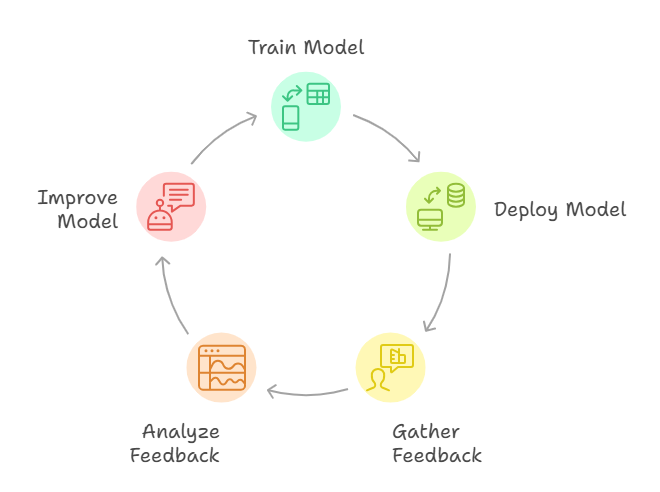
Our open-core platform, OpenRails, was designed to make this process seamless. Even if you don’t use it, I encourage you to study it as a framework for how structured feedback loops and guardrails should operate. When implemented properly, they not only enhance AI accuracy but ensure compliance, security, and trust.
Start Small. Move Fast. Scale Intelligently.
When all three pillars align—augmentation, high-quality data, and continuous feedback—you’re ready to move. But start deliberately.
Launch with a prototype that uses a small, safe subset of internal data. Treat it as a pilot: rapid, low-risk, and designed to surface quick insights. Once you see clear value, expand systematically, just as you would with an ERP or CRM rollout—incremental, measured, and tied to business goals.
Set monthly or quarterly milestones, track impact, and celebrate each win. This approach not only mitigates risk but keeps your teams motivated as they see tangible progress.
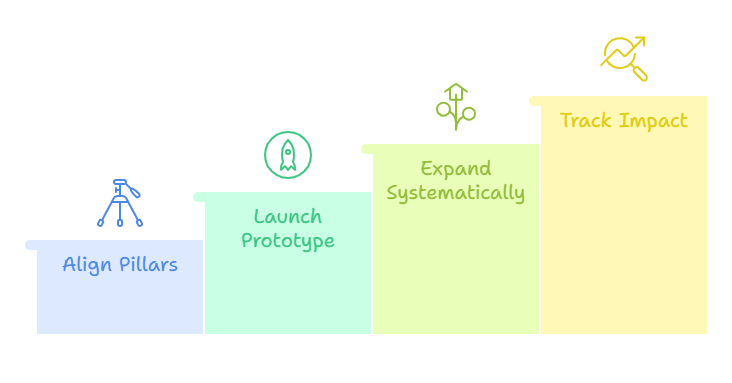
Final Thought
AI is no longer a futuristic concept—it’s the new competitive infrastructure.
But success doesn’t come from adopting AI for its own sake; it comes from deploying it strategically, starting in the right place, and building on real business outcomes.
So as you evaluate where to begin, remember:
Momentum drives adoption. Adoption drives ROI. ROI drives transformation.
That’s the sequence that separates leaders from laggards in the era of intelligent business.
If you’re ready to evaluate where your organization stands, explore our free AI Readiness Checkup and discover how to accelerate your first successful AI deployment.